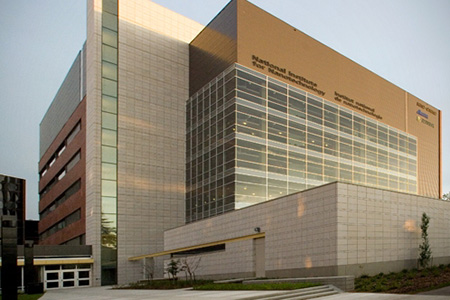
Facilities

The McCreery Group has access to world-class research facilities at both the University of Alberta and the National Institute for Nanotechnology (NINT). The group is based in NINT, a $52.2 million, 20,000 square metre building funded by the Federal Government of Canada, the Provincial Government of Alberta, the National Research Council (NRC), and the University of Alberta. NINT is one of the world's most technologically advanced research facilities and houses ultra quiet laboratory space – the quietest such space in Canada.
The building includes specialized spaces for laboratories in chemical and biochemical synthesis and analysis of the material structure at the atomic scale, as well as a Class 1000 Clean Room. Routine analytical equipment available to NINT researchers and the McCreery Group includes GC/MS, 600 MHz NMR, Raman microprobe, UV-vis and FTIR spectrometers, light scattering aparatus, X-ray powder and low-angle diffractometers, etc. NINT has also purchased the latest generation of scientific equipment, including electron and scanning probe microscopes, and chemical and material analysis instruments.
ACSES
The Alberta Centre for Surface Engineering and Science (ACSES) is an interdepartmental facility created jointly by the Faculty of Science and the Faculty of Engineering at the University of Alberta. ACSES helps to better understand that all-important, dynamic first layer of molecules on materials as diverse as microelectronics, medical implants, pharmaceuticals and oil sands. The centre is one of the best of its kind in North America.
nanoFAB
The nanoFAB is an open access micro and nano fabrication research facility. It provides the equipment, infrastructure and expertise necessary for its user community to achieve research goals. In addition to standard optical and UV photolithography, the nanoFAB has two electron beam lithography systems and a wide range of etching and deposition tools. The nanoFAB’s open access policy provides anyone with access to a one of a kind facility where users have control of their own processing.
Electron Microscopy
The electron microscopy facility at NINT features two transmission electron microscopes (TEM) and two scanning electron microscopes (SEM), as well as sample preparation and computer/data processing support. The transmission electron microscopes are located in a characterization suite with extremely low electromagnetic disturbances, temperature variations and mechanical vibrations.
NINT Clean Room
The Class 1000 Clean Room is for the production of nanostructured systems. This special laboratory is where the air is filtered or cleaned to remove dust and other particles. The NINT Clean Room includes the "Hybrid Device Facility" specially equipped for combining molecular electronics with conventional microelectric processing. Tools include photolithography, nanoimprint lithography, atomic layer deposition, electron beam deposition, SEM and a carbon nanotube reactor.